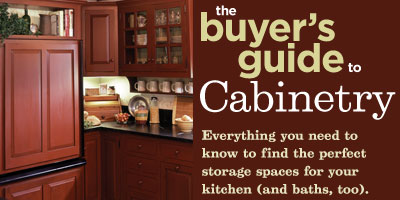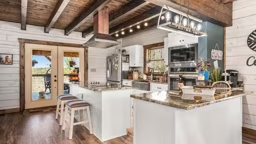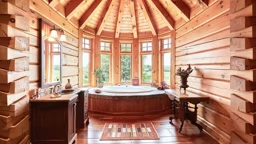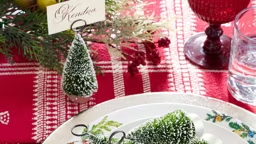
Some call it the "wow" factor: the response a beautiful kitchen generates. And at the very heart of that reaction is the cabinetry you choose. These days, the choices are considerable, even at the lesser-expensive end of the market. Manufacturers and custom furniture-makers are raising the bar and offering consumers an array of wood species, panel styles, finishes and accessories that can turn so-so kitchens (and baths), into sensational spaces. Where to begin? A little know-how goes a long way toward simplifying what can be an overwhelming decision-making process.
Easy as 1, 2, 3
The first thing you need to know is that there are three categories of cabinetry: stock, semi-custom and custom. The kind you select most likely will be dictated by your bottom-line. Set a budget and keep in mind that cabinets typically represent about 40 to 50 percent--the single largest cost--of your kitchen or bathroom's total project costs.STOCK: Ready When You Are
The least-expensive cabinetry option--stock cabinets--is available off the shelf (or on short notice) at most retail outlets. Stock widths vary depending on the manufacturer and come in 3-inch increments. Standard depths are 12 inches for wall cabinets and 24 inches for base cabinets. The choice of wood species and panel styles also are limited, but they won't bust your budget. The most recent survey by the Home Improvement Research Institute indicates the average cost of stock cabinetry is $2,840 for an entire kitchen.SEMI-CUSTOM: The Top Seller
Semi-custom is the top-selling cabinet category. By selecting semi-custom cabinets, you'll increase your size options and style choices while maintaining "bang-for-your-buck" value. When you consider door styles, wood species and finishes, "there are thousands of variations," according to Paul Radoy, design services manager at Merillat, a leading manufacturer of stock and semi-custom cabinetry based in Adrian, Michigan. You even can order specialty upgrades, such as glass inserts and storage accessories, to create a tailored look with more visual appeal. Lead times vary, but delivery is typically in the four-to-six-weeks range. Expect to pay at least 20 percent more for semi-custom than stock cabinets.CUSTOM: The Sky's the Limit
Custom cabinetry is the granddaddy of the storage universe, and prices can easily reflect that (think upper-five-figure range and higher). Here, there are no limits, nor concerns about making compromises, as long as your pockets are deep enough. Cabinets are built one at a time according to your specifications--size, color, finishes and whatever bells and whistles you want to add. The custom category offers the most sweeping choice of wood species, from exotic mahogany to reclaimed, even extinct varieties. What comes out of the woodworking shop is a finish in line with what you'd expect on high-end furniture.The Home's Soul
For more than three decades, Stephen Staples, master wood craftsman and owner of Staples Cabinet Makers in Plainville, Massachusetts, has been salvaging historic woods, such as longleaf yellow pine and American sweet chestnut, from homes, barns and mills scheduled for demolition. He then breathes new life into these timbers as cabinets, kitchen islands and other fine pieces of furniture. The kitchen, he says, is the center of the home"s soul, and nothing exudes warmth like vintage wood cabinetry. "What's beautiful about the wood is that most of these trees were growing when the pilgrims came to America," Stephen explains. Old-growth lumber is known for its density, strength and mellow patina. Stephen makes sure to leave evidence of its history in his creations. Some of his pieces still contain scars where old bolts rusted. Other boards, like those taken from a barn stall, might retain the nibble marks of a horse. In a bathroom vanity cabinet made from white pine barn wood, Stephen left in the ring used to tether the horse to the stall. "I take a wood that's beautiful and I wrap it in function," he says. Function is predicated on quality construction, and savvy home owners know it, according to Karen Laskoske, a designer at Crown Point Cabinetry, a custom cabinet company in Claremont, New Hampshire. "Builders and architects are always going to ask about construction, but home owners really know their stuff," says Karen. "They're smart consumers, and they want to know how you construct your cabinets."What to Look For
When it comes to cabinets, what you don't see is as important as what is visible. Wood is used for the visible sections only: the doors, drawer fronts and cabinet face frame. The hidden panels are actually built of engineered wood, either wood composites or sturdier plywood in better-made models. Corner dovetail drawer joinery and a metal under-mount drawer slide system are hallmarks of quality production. In some classes of cabinetry, these are standard features; at the low end of the market, they may be available as upgrades. The longer you expect to stay in your home, the more quality workmanship will pay dividends in durability and functionality.From Colonial to Contemporary
Now we come to the fun part: style. Shaker? Early American? Colonial? Contemporary? Start by determining what type of cabinet design best complements your (and your home's) personality. If it's a Craftsman-influenced log home, Karen says she might suggest Arts and Crafts cabinetry, characterized by its strong geometric lines, multi-paneled doors and arched Mission foot detailing on the base of the cabinets. Another key consideration is where the kitchen falls in the floorplan, according to Merillat's Paul Radoy. If the kitchen flows into another room, like the great room, the cabinetry will impact the overall aesthetic on the adjoining living space.Style Watch
Your wood choice and your home's style should go hand-in-hand. Quarter-sawn white oak is Mission wood, for instance; pine points to early American. Door panels are yet another important style decision. For a contemporary look, simple contours work best, while beaded inset frames work well for more formal spaces. For a more traditional look, go for raised center panels and arched doorframes. Wood clearly plays a bigger role in log homes than in standard frame houses, but Karen says home owners shouldn't feel compelled to match cabinet wood species to interior walls, floors or beams. Even for those who like a fully timbered interior? "It doesn't need to be all the same," she says. "I've done cherry cabinetry in several pine log homes. It gives a rustic home a formal touch." Hand-applied glazes give cabinetry a timeless, handcrafted appearance that enhances the natural character of the wood grain. In some cases, eye-catching glazes are even replacing ornamental detailing on custom designs.No Competition
Karen says that the greater the variation between the cabinetry's wood species and the home's interior woodwork, the lesser the chance that log walls will compete with the tones and grain of the cabinetry. In fact, more and more log home owners are opting for painted cabinets over wood tones entirely. "Painted cabinets are the most popular thing we're doing now," Karen notes. "For log homes, painted cabinets give the interior that little extra contrast." White, off-white and oyster continue to be stylish choices.Now You See It, Now You Don't
"When people give their kitchens a facelift," says Karen, "the biggest thing they want is to get clutter off the countertops and have a place for everything." Today's manufacturers have responded in a big way. Built-in spice racks, cutting blocks and slide-out recycling centers are just a few ways to give a home now-you-see-it, now-you-don't utility. Rollout drawers for base cabinets make it easy to access pots, pans and small appliances. Along with standby favorites such as corner Susans and tray dividers, pullout towel racks, pull-down cookbook holders and wine storage units are practical upgrades that can be ordered even at the value-priced end of the market. So now you can be stylish and storage-friendly--without spending a fortune.This article is featured in the May 2006 issue of Log Home Design.











